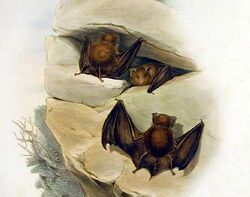Biology:Hipposideros
| Hipposideros | |
|---|---|

| |
| Fawn leaf-nosed bat (H. cervinus) | |
| Scientific classification | |
| Domain: | Eukaryota |
| Kingdom: | Animalia |
| Phylum: | Chordata |
| Class: | Mammalia |
| Order: | Chiroptera |
| Family: | Hipposideridae |
| Genus: | Hipposideros Gray, 1831 |
| Type species | |
| Vespertilio speoris Schneider, 1800
| |
| Species | |
|
See text | |
Hipposideros is one of the most diverse genera of bats, with more than 70 species. They are collectively called roundleaf bats after the shape of their nasal ornament. It is the type genus of the family Hipposideridae. It is divided into species groups based on morphology.
Some species that were previously placed in Hipposideros are now placed in the related genera Doryrhina and Macronycteris.[1] Conversely, the genus Paracoelops, which was considered distinct until 2012, is now synonymized with Hipposideros, as the only species turned out to be based on a specimen of Hipposideros pomona.[2]
Species
armiger species group
- Great roundleaf bat, H. armiger
- Ha Long roundleaf bat, H. alongensis
- Pendlebury's roundleaf bat, H. pendlebury
- Lesser great leaf-nosed bat, H. turpis
bicolor species group
- Dusky leaf-nosed bat, H. ater
- Benito roundleaf bat, H. beatus
- Bicolored roundleaf bat, H. bicolor
- Short-headed roundleaf bat, H. breviceps
- Sundevall's roundleaf bat, H. caffer
- Spurred roundleaf bat, H. calcaratus
- Fawn leaf-nosed bat, H. cervinus
- Ashy roundleaf bat, H. cineraceus
- Large Mindanao roundleaf bat, H. coronatus
- Cox's roundleaf bat, H. coxi
- Timor roundleaf bat, H. crumeniferus
- Short-tailed roundleaf bat, H. curtus
- Borneo roundleaf bat, H. doriae
- Khajuria's leaf-nosed bat, H. durgadasi
- Dayak roundleaf bat, H. dyacorum
- Sooty roundleaf bat, H. fuliginosus
- Fulvus roundleaf bat, H. fulvus
- Cantor's roundleaf bat, H. galeritus
- Hipposideros gentilis[3]
- Thailand roundleaf bat, H. halophyllus
- Kolar leaf-nosed bat, H. hypophyllus
- Jones's roundleaf bat, H. jonesi
- Phou Khao Khouay leaf-nosed bat, H. khaokhouayensis
- H. kingstonae
- H. kunzi
- Lamotte's roundleaf bat, H. lamottei
- Big-eared roundleaf bat, H. macrobullatus
- Maggie Taylor's roundleaf bat, H. maggietaylorae
- Aellen's roundleaf bat, H. marisae
- Malayan roundleaf bat, H. nequam
- Nicobar leaf-nosed bat, H. nicobarulae[4]
- Philippine forest roundleaf bat, H. obscurus
- Orbiculus leaf-nosed bat, H. orbiculus
- Biak roundleaf bat, H. papua
- Pomona roundleaf bat, H. pomona
- Philippine pygmy roundleaf bat, H. pygmaeus
- Ridley's leaf-nosed bat, H. ridleyi
- Laotian leaf-nosed bat, H. rotalis
- Noack's roundleaf bat, H. ruber
cyclops species group
This group no longer includes the cyclops roundleaf bat (Doryrhina cyclops), which is now placed in the separate genus Doryrhina.
- Telefomin roundleaf bat, H. corynophyllus
- Hill's roundleaf bat, H. edwardshilli
- Fly River roundleaf bat, H. muscinus
- Semon's roundleaf bat, H. semoni
- Northern leaf-nosed bat or narrow-eared roundleaf bat, H. stenotis
diadema species group
- Makira roundleaf bat, H. demissus
- Diadem roundleaf bat, H. diadema
- Fierce roundleaf bat, H. dinops
- Crested roundleaf bat, H. inexpectatus
- Arnhem leaf-nosed bat, H. inornatus
- Indian roundleaf bat, H. lankadiva
- Large Asian roundleaf bat, H. lekaguli
- Peleng leaf-nosed bat, H. pelingensis
larvatus species group
- Grand roundleaf bat, H. grandis
- Intermediate roundleaf bat, H. larvatus
- Maduran leaf-nosed bat, H. madurae
- Sorensen's leaf-nosed bat, H. sorenseni
- Sumba roundleaf bat or Sumban leaf-nosed bat, H. sumbae
megalotis species group
- Ethiopian large-eared roundleaf bat, H. megalotis
pratti species group
- Shield-faced roundleaf bat, H. lylei
- Pratt's roundleaf bat, H. pratti
- Swinhoe's roundleaf bat, H. swinhoei
speoris species group
- Aba roundleaf bat, H. abae
- Schneider's leaf-nosed bat, H. speoris
Uncertain group
- Hipposideros atrox
- Boeadi’s roundleaf bat, H. boeadii
- Sulawesi roundleaf bat, H. celebensis
- Griffin's leaf-nosed bat, H. griffini
- Khasian leaf-nosed bat, H. khasiana
- Shield-nosed leaf-nosed bat H. scutinares
- Hipposideros tephrus
- House-dwelling leaf-nosed bat, H. einnaythu
- Wollaston's roundleaf bat, H. wollastoni
Fossil species
The species Hipposideros bernardsigei Hand, 1997 describes one of many species of bats discovered in the north of Australia, the Riversleigh fauna, and appears to be a member of an Australopapuan group in an early radiation of the genus. The first hipposiderid to be described from Pliocene deposits at Riversleigh was Hipposideros winsburyorum Hand, 1999.[5] Other named fossil species allied to Hipposideros include Hipposideros (Pseudorhinolophus), Hipposideros collongensis, Hipposideros conquensis, Hipposideros felix, Hipposideros minor, Hipposideros morloti, Hipposideros omani and Hipposideros schlosseri.[6]
References
- ↑ Foley, Nicole M.; Goodman, Steven M.; Whelan, Conor V.; Puechmaille, Sébastien J.; Teeling, Emma (2017). "Towards navigating the Minotaur's labyrinth: Cryptic diversity and taxonomic revision within the speciose genus Hipposideros (Hipposideridae)". Acta Chiropterologica 19 (1): 1–18. doi:10.3161/15081109ACC2017.19.1.001.
- ↑ Thong, Vu Dinh; Dietz, Christian; Denzinger, Annette; Bates, Paul J.J.; Puechmaille, Sébastien J.; Callou, Cécile; Schnitzler, Hans-Ulrich (2012). "Resolving a mammal mystery: the identity of Paracoelops megalotis (Chiroptera: Hipposideridae)". Zootaxa 3505: 75–85.
- ↑ Srinivasulu, C.; Srinivasulu, B.; Srinivasulu, A. (2020). "Hipposideros gentilis". IUCN Red List of Threatened Species 2020: e.T180991219A180991293. doi:10.2305/IUCN.UK.2020-3.RLTS.T180991219A180991293.en. https://www.iucnredlist.org/species/180991219/180991293. Retrieved 19 January 2024.}
- ↑ Douangboubpha, Bounsavane; Bumrungsri, Sara; Satasook, Chutamas; Soisook, Pipat; Hla Bu, Si Si; Aul, Bandana; Harrison, David L.; Pearch, Malcolm J. et al. (2011). "A New Species of Small Hipposideros (Chiroptera: Hipposideridae) from Myanmar and a Revaluation of the Taxon H. Nicobarulae Miller, 1902 from the Nicobar Islands". Acta Chiropterologica 13: 61–78. doi:10.3161/150811011X578624.
- ↑ Hand, S.J.; Godthelp, H. (1999). "First Australian Pliocene species of Hipposideros (Microchiroptera: Hipposideridae)". Records of the Western Australian Museum Supplement 57: 299–306.
- ↑ "Fossilworks: Hipposideros". http://www.fossilworks.org/cgi-bin/bridge.pl?a=taxonInfo&taxon_no=40649.
- Simmons, N.B. (2005). "Order Chiroptera". in Wilson, D.E.; Reeder, D.M. Mammal Species of the World: A Taxonomic and Geographic Reference (3rd ed.). Johns Hopkins University Press. p. 314. ISBN 978-0-8018-8221-0. OCLC 62265494. http://www.departments.bucknell.edu/biology/resources/msw3/browse.asp?id=13800705.
Wikidata ☰ Q268051 entry
 |

